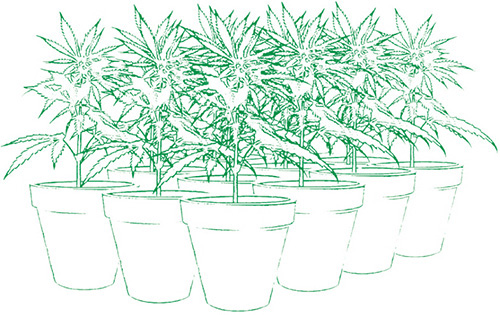Anyone walking into a large California or Colorado medical cannabis dispensary for the first time would be floored by the selection. Dozens of herbal cannabis varieties are advertised on the plasma screen menu. Anyone coming from outside of the dispensary world would be hard-pressed to have ever seen more than a few varieties of cannabis in his/her entire life. And now it appears as if hundreds of varieties are available through dispensaries, seed companies, and the underground. And the only problem? It’s all nonsense. This apparent diversity is nothing more than a bunch of highly inbred varieties, where the similarities far outnumber the differences. Take a visit to a large cultivation facility and really look for the differences. They are there, just tough to spot. Most of the leaflets are wide, even on the so-called sativa varieties like Sour Diesel. There is almost nothing that resembles a sativa from the 1970s, except perhaps Trainwreck. Basically, you are looking at a room full of cousins and perhaps even siblings. And what about the classic varieties from the past? Colombian Gold, Maui Wowie, Acapulco Gold, or Thai? Not to be found in the United States, and haven’t been seen in decades. What happened to them? Welcome to the isolated hamlet of modern cannabis genetics, where a bunch of related folk have intermarried and produced some odd offspring. Add to that a current preference for growing plants from cuttings rather than seeds, which hampers genetic diversity even more. Remember that today’s medical varieties came of age during the government’s War on Drugs. They were selected for THC content, ease of indoor cultivation, high yield, and minimal space requirements. In other words, to create varieties that could be hidden and cultivated with the smallest footprint possible within the shortest period of time. And that’s what we’ve got. Those Santa Cruz Hazes that weren’t ready for harvest until Christmas? That tall wispy Kona Gold? Both dead as disco. Although the traits that made these varieties different in the sixties and seventies are still there, they’ve just shrunk into recessive traits, awaiting an iconoclastic breeder to coax them from hiding among the more popular genes. All this inbreeding has made for high-yielding and potent plants, just not always medicinally interesting ones. Cloning cannabis plants allows growers to focus on varieties that fulfill a certain number of criteria, be it THC content, rapid growth, or the size of plants and flowers, for example. The very first Afghan genetics to come to the U.S. in the late 1970s had a reasonable chance of being representative of the “Af-Pak” hashish genetics that filled the region before the Soviet invasion of Afghanistan. But they weren’t. Instead, the plants that were selected were ones that expressed extremely high levels of THC, unlike the more common THC/CBD genetics found in the region. One of these selected plants became the legendary Afghan #1. The irony was that it would be tough to find another plant in Afghanistan or Pakistan that resembles it, today or even back in 1975. Afghan #1 was selected for its high resin content, its compact shape, and its short harvest time, but also its high THC content. Was it the most medicinally interesting plant in Afghanistan? No. In fact, it probably wasn’t the most medicinally interesting cannabis plant in the village. But there is good news here. There are many places around the world where unique cannabis genetics still survive. Perhaps not as many as there were 40 years ago, but plenty, nonetheless. The better news? Today we understand a lot more about the plant, and about what can make cannabis interesting from a medical standpoint. Let’s explode a myth right now: the myth of indica and sativa. Ask most cannabis patients about sativas and they say: stimulating, mood-elevating, and good for daytime use. Ask them about indicas and you’ll hear: body high, relaxing, stony, sedative, and more potent than sativas. The descriptors are correct, but the names are wrong. Ten years ago, Karl Hillig was working on his doctoral degree at Indiana University. Part of Hillig’s dissertation was to examine the difference in the genetics between cannabis varieties from around the world, and he made an interesting discovery.62 All drug strains of cannabis shared a relatively narrow range of genes. And all fiber strains of cannabis, the ones we call hemp, shared another small set of genes. And there was not as much crossover between them as might have been expected. So, Hillig decided to clean up the nomenclature. He decided that all fiber varieties, hemp, should be classified as Cannabis sativa. He classified all drug varieties as Cannabis indica, but noted some crucial distinctions. He divided drug indica cannabis into broad-leafleted drug (BLD) and narrow-leafleted drug (NLD) varieties. Most of today’s drug cannabis varieties are a hybrid of these two biotypes, leaning toward the BLD side in appearance, but possessing characteristics from both cultivars. Most NLD-dominant hybrids are somewhat stimulating and cerebral when compared to pure BLDs such as Bubba Kush. What about Cannabis sativa? It turns out that sativas are much more than just fiber and rope. They carry the gene to make the enzyme that converts CBG into CBD, rather than THC. All CBD genetics appear to trace their origins to hemp varieties of cannabis. And the CBD to THC hashish cultivars of the Middle East are likely true indica/sativa crosses. The classic early drug strains, such as Haze, contained some CBD along with THC. Eventually, the distinction between indica and sativa effects will be based on a variety’s terpene, rather than its cannabinoid, content.
GENOTYPES, PHENOTYPES, AND CHEMOTYPES OF MEDICAL CANNABIS
Indica vs. Sativa
< div class='tao-gold-member'>
Phenotypes, and Chemotypes of Medical Cannabis
Only gold members can continue reading. Log In or Register to continue

Full access? Get Clinical Tree



